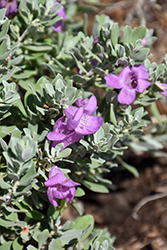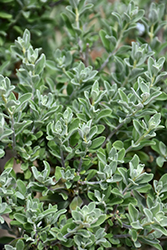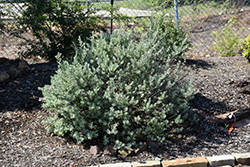Fri & Sat 8am - 8pm
Sun 8am - 7pm
Anytown, USA 12345
fax: 261.787.0463
e-mail: info@successgc.com


Plant Finder

RenegadeTexas Sage
Leucophyllum frutescens 'Renegade'
Height: 6 feet
Spread: 6 feet
Sunlight:
![]()
Hardiness Zone: 7b
Other Names: Texas Ranger, Silverleaf, Cenizo, Ash Bush
Description:
An upright shrub with silvery gray-green foliage; showy purple-pink flowers in summer; a great water conservation plant, good for dry, hot, rocky sites; must have well drained, alkaline soil; prune lightly to maintain fullness; must have full sun
Ornamental Features
RenegadeTexas Sage features showy clusters of purple flowers with pink overtones at the ends of the branches from mid summer to early fall. It has attractive grayish green foliage with hints of silver. The fuzzy oval leaves are highly ornamental and remain grayish green throughout the winter. The smooth gray bark adds an interesting dimension to the landscape.
Landscape Attributes
RenegadeTexas Sage is a multi-stemmed evergreen shrub with an upright spreading habit of growth. Its relatively fine texture sets it apart from other landscape plants with less refined foliage.
This shrub will require occasional maintenance and upkeep, and is best pruned in late winter once the threat of extreme cold has passed. It is a good choice for attracting birds, bees and butterflies to your yard, but is not particularly attractive to deer who tend to leave it alone in favor of tastier treats. It has no significant negative characteristics.
RenegadeTexas Sage is recommended for the following landscape applications;
- Mass Planting
- Hedges/Screening
- General Garden Use
- Container Planting
Planting & Growing
RenegadeTexas Sage will grow to be about 6 feet tall at maturity, with a spread of 6 feet. It has a low canopy with a typical clearance of 1 foot from the ground, and is suitable for planting under power lines. It grows at a medium rate, and under ideal conditions can be expected to live for 40 years or more.
This shrub should only be grown in full sunlight. It prefers dry to average moisture levels with very well-drained soil, and will often die in standing water. It is considered to be drought-tolerant, and thus makes an ideal choice for xeriscaping or the moisture-conserving landscape. It is particular about its soil conditions, with a strong preference for poor, alkaline soils, and is able to handle environmental salt. It is highly tolerant of urban pollution and will even thrive in inner city environments. This is a selection of a native North American species.
RenegadeTexas Sage makes a fine choice for the outdoor landscape, but it is also well-suited for use in outdoor pots and containers. With its upright habit of growth, it is best suited for use as a 'thriller' in the 'spiller-thriller-filler' container combination; plant it near the center of the pot, surrounded by smaller plants and those that spill over the edges. It is even sizeable enough that it can be grown alone in a suitable container. Note that when grown in a container, it may not perform exactly as indicated on the tag - this is to be expected. Also note that when growing plants in outdoor containers and baskets, they may require more frequent waterings than they would in the yard or garden.


